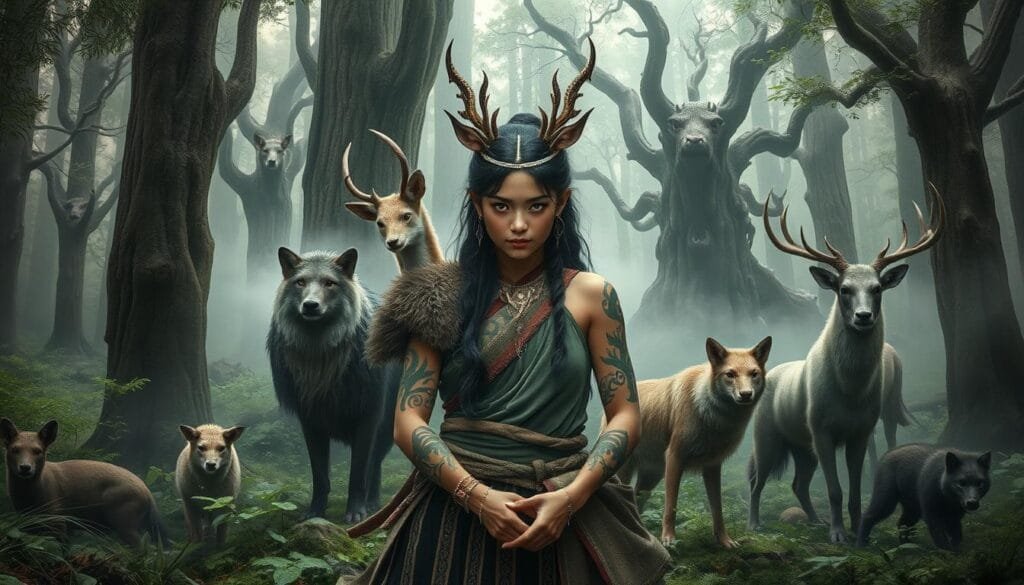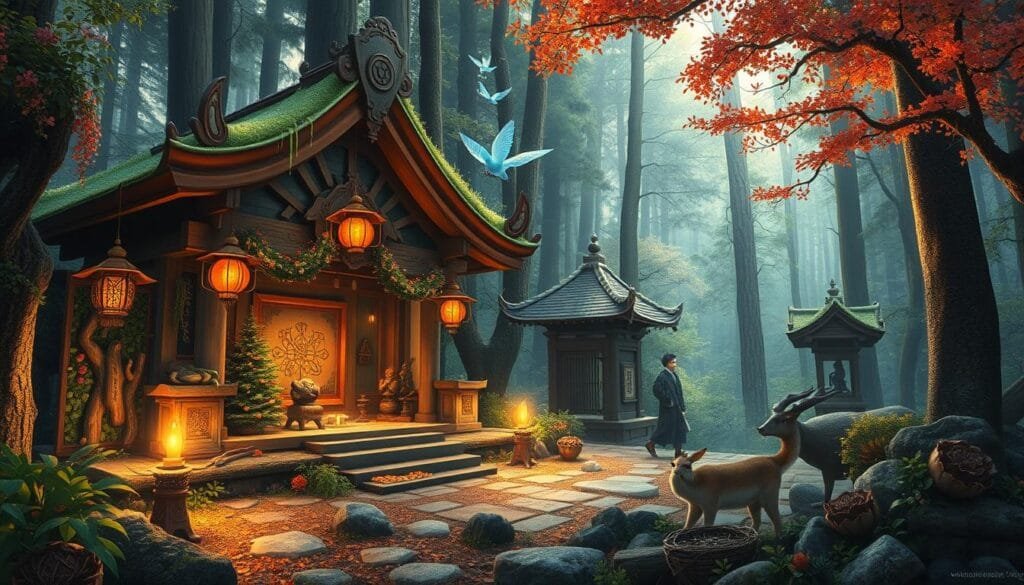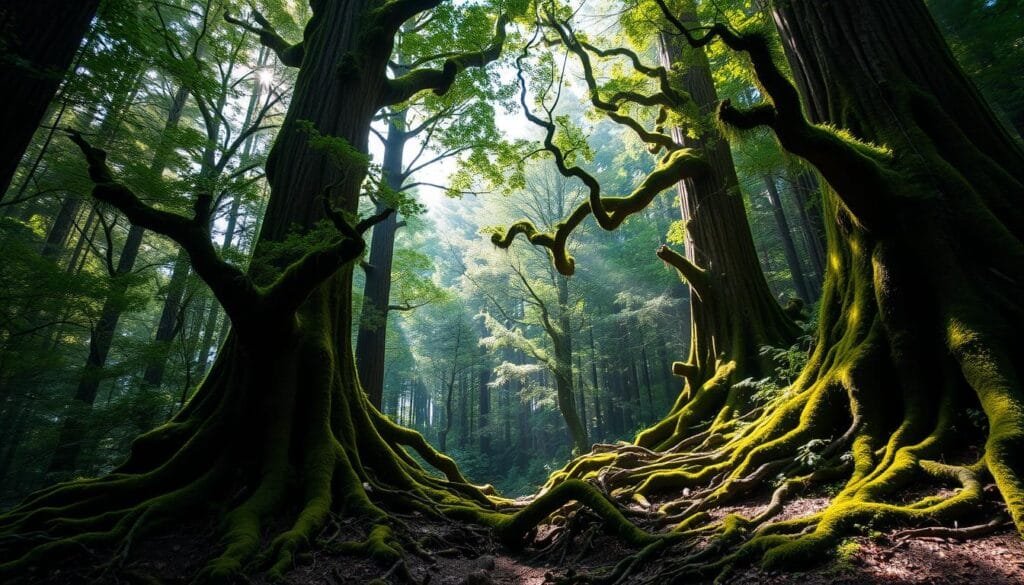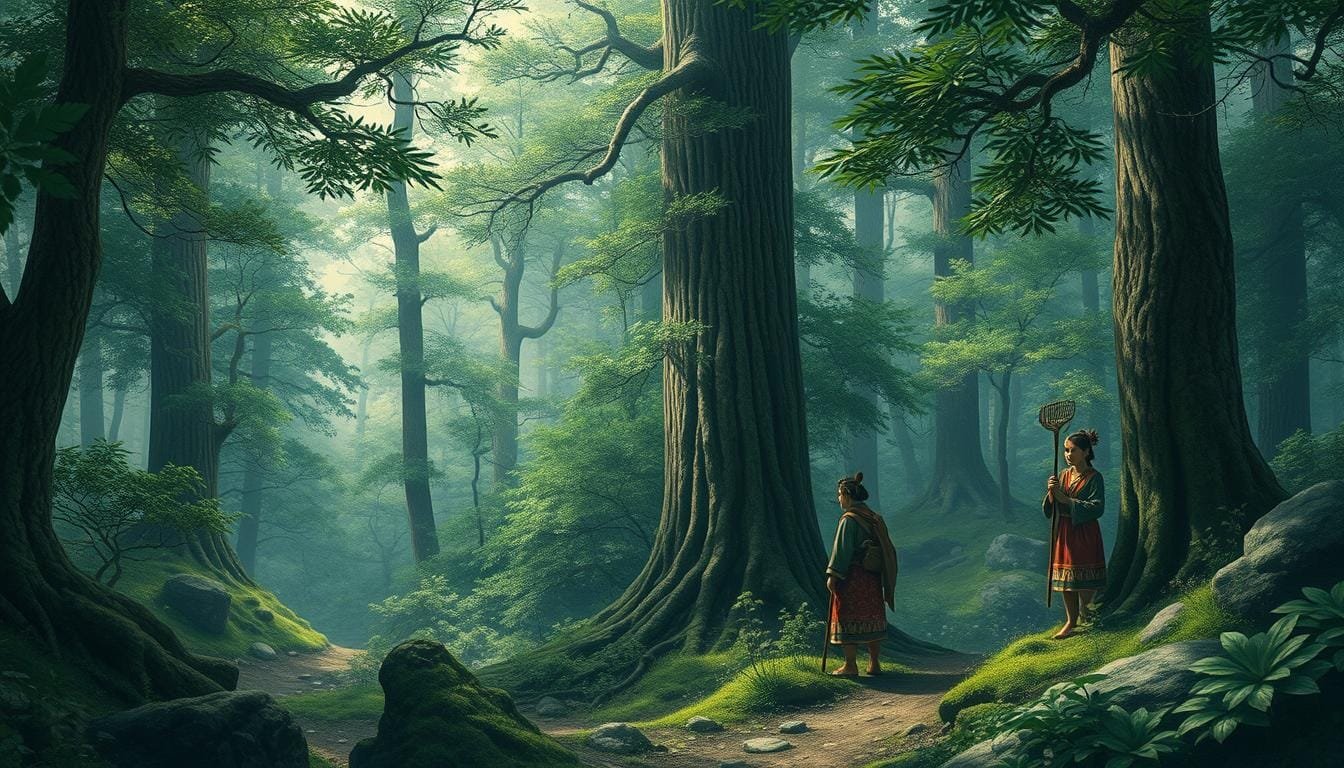Why is “Princess Mononoke,” with its engaging plot and memorable characters, also a nod to Ainu culture? This has stirred curiosity among scholars and fans. They talk about how films can reflect cultures. Hayao Miyazaki’s films blend history and culture in their stories.
The film, made by Studio Ghibli and directed by Miyazaki, shows San as a character. Some say San is like the indigenous Ainu of Japan. The movie not only spreads a message about protecting the environment. It also showcases Ainu culture. Miyazaki highlights nature, spirituality, and culture, akin to Ainu traditions. This makes us wonder if San really represents Ainu culture.
Key Takeaways
- “Princess Mononoke” mixes real history with fantasy, shining a light on Ainu culture.
- Some think San, or Princess Mononoke, shows traits influenced by the Ainu of Japan.
- Miyazaki’s films delve into themes like nature, the spiritual world, and cultural differences.
- The movie opens up talks about how cultures are shown in films.
- Studio Ghibli’s stories are in tune with the Ainu people’s historical journey.
- The Ainu, a minority group in Japan, were officially recognized in 2008.
- With over 19 billion yen in global earnings, the film’s cultural impact is huge.
Introduction to Princess Mononoke and its Historical Context
“Princess Mononoke” takes us back to Muromachi Era Japan, from 1336 to 1573. Hayao Miyazaki directed this film. It deals with social changes and the rise of samurai clans at this time. The Muromachi Era plays a big role in the story, mixing history and myths together.
The story focuses on the fight between growing industries and nature’s keepers. It’s set during the Muromachi Era, showing the struggle between keeping traditions and embracing progress. We see how this battle affects the environment and society, which adds depth to the story.
Miyazaki uses detailed animation and storytelling to bring early Japanese animation to life. The film connects old Japanese art forms with modern stories. It also honors Japan’s animation history. A deeper look into this aspect of Japanese animation is available here.
In 1985, Hayao Miyazaki, Isao Takahata, and Toshio Suzuki founded Studio Ghibli. This started a new chapter in anime, leading to films like “Princess Mononoke” and “Spirited Away.” “Spirited Away” even won an Academy Award. Today, Studio Ghibli is the top animation studio outside of Hollywood. Their films explore Japan’s history and culture in unique ways.
Before Ghibli, anime had major milestones, like “Hakujaden” in 1958. It was Japan’s first color anime. This paved the way for rich historical stories, like Princess Mononoke.
| Event/Development | Impact on Japanese Animation |
|---|---|
| Studio Ghibli’s Founding (1985) | Revolutionized storytelling through historical and cultural narratives |
| Release of “Princess Mononoke” (1997) | Showcased the complex interplay of tradition and modernization |
| Academy Award for “Spirited Away” (2001) | International recognition of Japanese animation excellence |
| Significant Post-War Animation Growth | Increased production and global popularity |
“Princess Mononoke” explores environmental themes, inspired by the Muromachi Era’s history. The story contrasts human progress with nature. This adds a meaningful layer to the historical setting. It shows how traditional Japanese stories still influence and challenge us today.
Ashitaka and His Emishi Heritage
“Princess Mononoke” depicts Ashitaka as part of the Emishi, an important tribe. The Emishi fought against Japanese invasion and were pushed to the fringes. This story is closely linked to the Ainu, Japan’s indigenous group, showing a deep connection in Ashitaka’s roots and the The Emishi’s Historical Connection to the Ainu.
Ashitaka’s journey in the film mirrors the theme of cultural displacement in film. He moves from his homeland to modern areas, showing a clash between old ways and new challenges. This reflects the Emishi and Ainu’s struggles, making his story a symbol of historical displacement.
In an Ashitaka character analysis, we see his strong cultural ties. He fights to save his village from a curse, aiming for peace between humans and nature. His story brings attention to the trials of indigenous people, through an authentic representation.
Founded in 1985, Studio Ghibli stands as a giant in animation, second to Hollywood. Ghibli’s “Spirited Away” won an Academy Award, with films often leading Japan’s box office. “Princess Mononoke,” from 1997, enriches Ghibli’s legacy by exploring rich cultural narratives, emphasizing Ashitaka’s moving journey through cultural displacement in film.
Is San Princess Mononoke a Nod to the Ainu Culture?
San, known as Princess Mononoke, shows a deep link to Ainu traditions through her life. Raised by wolves and protecting the forest fiercely, her bond with nature and spiritual beliefs align with Ainu culture. This connection highlights the shared elements between San and Ainu traditions, showcasing indigenous cultures in the film.

Studio Ghibli’s Princess Mononoke skillfully integrates Ainu traditions into its story. It reflects on San’s respect for the sacred, her connection to the land, and mirrors Ainu spiritual practices. By presenting such characters, the film enriches its narrative and pays homage to Ainu spiritual views.
The film also celebrates nature’s sanctity, often through spiritual beings or “kami”. This echoes the spiritual interactions found in Ainu rituals. This movie element helps bridge cultural gaps, showing universal values like nature’s respect and spiritual balance.
By drawing parallels between San and Ainu traditions, the film encourages viewers to see the depth in its story and indigenous culture representation. It reflects on the impact of cultural and historical contexts in animation, making “Princess Mononoke” stand out to a broad audience.
Shinto Beliefs and Nature in Princess Mononoke
In “Princess Mononoke,” kami play a key role, showing the Shinto idea that spirits live in nature. This highlights how deeply connected nature and spirituality are in the story. Kami are seen as mighty forces that keep things alive but also pose challenges.

The Forest Spirit is a life and death god, showing how Shinto respects nature as sacred. It shows forests and natural spaces are full of spirits that keep the world balanced. Through the Forest Spirit, we see how kami influence the story and highlight environmental and spiritual ideas.
The film mixes Shinto traditions into its mythical story, blending real beliefs with fiction. By doing this, Miyazaki shines a light on Shinto’s impact on Japanese culture. This careful depiction links viewers to nature and spirituality, making the film authentically cultural and meaningful.
The Geographical Inspirations Behind the Sacred Forest
The mystical forests in “Princess Mononoke” draw inspiration from real places. A key example is Yakushima: The Real-Life Model for Princess Mononoke’s Forest. Yakushima is a beautiful island in Japan known for its ancient cedar trees and rich ecosystems. It captures the magic and wonder that Studio Ghibli brings to life.

Yakushima’s ancient forests seem almost mystical and are considered sacred. Using Yakushima as a model, the filmmakers highlighted natural beauty. This adds depth to the film’s environmental messages and enhances its visual impact.
But Yakushima isn’t the only place that inspired the film. The design also reflects Kyoto’s influence during the Muromachi period. This era is noted for cultural growth and the fusion of nature and architecture. Scenes that include ancient temples and well-kept gardens showcase this blend, underscoring the connection between humans and nature.
The film’s geographical inspirations go beyond looks. They also give the fantastic elements a base in real places. This authenticity makes the environmental themes more relatable. It shows the real threats to biodiversity and the delicate balance between people and nature.
Environmental Themes in Princess Mononoke
“Princess Mononoke” explores the deep ties between humans and nature. It shows how human actions affect nature. The story is set against the backdrop of Irontown and its ironworks. This symbolizes the impact of industrial growth on the environment. The film presents progress as both beneficial and harmful.
The movie makes us think about how progress harms nature. It uses a real example to highlight its message. In 2008, a plan was proposed to cut trees for tourism. This shows the conflict between enjoying nature and preserving it.
Shsen Gorge is known for its beauty but faces deforestation. It was declared a park in 1950. The story in “Princess Mononoke” mirrors this real-life issue. It shows how human growth threatens nature.
Over time, tourists wanted clearer views, leading to frustration. The trees at Shsen Gorge were seen as obstacles. Yet, the park manages to keep its natural balance. The film “Princess Mononoke” also portrays this struggle for balance.
| Environmental Issue | Shsen Gorge Real-World Example | Parallel in Princess Mononoke |
|---|---|---|
| Tourism vs. Conservation | Suzuki Takehiko’s proposal for tree cutting to enhance tourist view | Conflict between Irontown’s industrial growth and forest spirits |
| Human Activity Impact | Decades of deforestation to reveal rock formations | Deforestation by Irontown affecting the sacred forest |
| Ecological Preservation | Maintaining ecosystem balance despite tourism | Struggle to maintain forest integrity amidst human activities |
Miyazaki’s “Princess Mononoke” warns us about environmental challenges. It shows how our actions impact the planet. The film urges us to find a way to live in harmony with nature.
Conclusion
Throughout our analysis of “San Princess Mononoke,” we’ve uncovered many layers. The film’s impact grows from its use of Ainu elements, showing Hayao Miyazaki’s deep storytelling. By looking into Ashitaka’s heritage, Shinto beliefs, and the forest’s inspiration, we see Japan’s rich cultural blend.
The story’s environmental themes echo Miyazaki’s lasting influence. His focus on respecting culture and nature has touched people around the world. “Princess Mononoke” doesn’t just entertain; it teaches. It helps us appreciate Japan’s history and its environmental concerns more.
In the end, the movie proves cinema’s strength in shaping our views on history, nature, and culture. Reflecting on Miyazaki’s significant work, it’s clear that “Princess Mononoke” motivates and connects. Its place in film study is secure. Miyazaki’s legacy goes beyond animation. He deeply teaches about cultural and environmental awareness.
FAQ
How does “San Princess Mononoke” incorporate Ainu culture?
“Princess Mononoke” introduces San, modeled after the Ainu people. Miyazaki respects Ainu culture through her character. This shows how the film values indigenous traditions.
What is the historical context of “Princess Mononoke”?
The story is in Japan’s Muromachi period, a time of change. It shows the struggle between growing society and nature.
How is Ashitaka’s character connected to the Emishi tribe?
Ashitaka comes from the Emishi, who fought against Japan’s rulers. His story reflects the Ainu’s challenges, showing cultural loss.
Does San’s character represent Ainu cultural traditions?
Yes, San values nature like the Ainu do. This bond shows in her life, honoring indigenous beliefs.
What role do Shinto beliefs and kami play in “Princess Mononoke”?
Shinto beliefs shape the film. Kami, or spirits, are key to the story. They bring nature’s power to life, connecting to the film’s messages.
What are the real-life geographical inspirations behind the film’s sacred forest?
The film’s forests are based on Yakushima and Kyoto. These places bring real-world nature into the story, blending fact and fantasy.
How does Miyazaki address environmental themes in the film?
Miyazaki explores how humans affect nature. Irontown’s industry shows this tension. He warns against harming our world.
